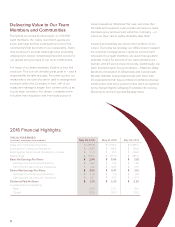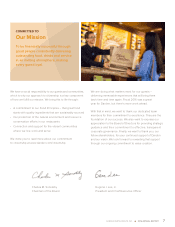Red Lobster 2016 Annual Report Download - page 20
Download and view the complete annual report
Please find page 20 of the 2016 Red Lobster annual report below. You can navigate through the pages in the report by either clicking on the pages listed below, or by using the keyword search tool below to find specific information within the annual report.
MANAGEMENT’S DISCUSSION AND ANALYSIS
OF FINANCIAL CONDITION AND RESULTS OF OPERATIONS
DARDEN
16
impairment loss. Based on a review of operating results for each of our
restaurants, the amount of net book value associated with lower performing
restaurants that would be deemed at risk for impairment is not material to
our consolidated financial statements.
Valuation and Recoverability of Goodwill and Trademarks
Goodwill and trademarks are not subject to amortization and have been
assigned to reporting units for purposes of impairment testing. The reporting
units are our restaurant brands. At May 29, 2016, we had the following
amounts recorded as goodwill and trademarks at our brands:
(in millions)
Goodwill Trademarks
Olive Garden $ 30.2 $ —
LongHorn Steakhouse 49.3 307.8
The Capital Grille 401.6 147.0
Yard House 369.2 109.3
Eddie V’s 22.0 10.5
Total $872.3 $574.6
A significant amount of judgment is involved in determining if an
indicator of impairment has occurred. Such indicators may include, among
others: a significant decline in our expected future cash flows; a sustained,
significant decline in our stock price and market capitalization; a significant
adverse change in legal factors or in the business climate; unanticipated
competition; the testing for recoverability of a significant asset group within
a reporting unit; and slower growth rates. Any adverse change in these
factors could have a significant impact on the recoverability of these assets
and could have a material impact on our consolidated financial statements.
Consistent with our accounting policy for goodwill and trademarks,
we performed our annual impairment test of our goodwill and trademarks as
of the first day of our fiscal fourth quarter. Based on the results of the step
one impairment test, no impairment of goodwill or trademarks was indicated.
Changes in circumstances, existing at the measurement date or at other
times in the future, or in the numerous estimates associated with manage-
ment’s judgments and assumptions made in assessing the fair value of our
goodwill and trademarks, could result in an impairment loss of a portion or
all of our goodwill or trademarks.
A key assumption in our goodwill impairment test is the weighted-average cost of capital utilized for discounting our cash flow estimates in estimating
the fair value of our brands under an income approach. A key assumption in our trademark fair value estimate is the discount rate utilized in the relief-from-
royalty method. The following table illustrates the sensitivity to a one-percentage-point change in our weighted-average cost of capital assumption for goodwill
and our discount rate assumption in our trademark valuation model.
Goodwill Sensitivity Trademark Sensitivity
Impact to Fair
Value from a One- Impact to Fair
Amount by Percentage-Point Amount by Value from a One-
Which Fair Increase in Which Fair Percentage-Point
Weighted-Average Value Exceeded Weighted-Average Value Exceeded Increase in the
(dollars in millions)
Cost of Capital Carrying Value Cost of Capital Discount Rate Carrying Value Discount Rate
LongHorn Steakhouse 9.5% $1,928.2 $(202.0) 10.5% $506.0 $(83.5)
The Capital Grille 9.0% $ 306.2 $ (71.2) 10.0% $ 91.3 $(25.4)
Yard House 12.0% $ 368.6 $ (72.4) 13.0% $118.7 $(20.5)
Eddie V’s 15.0% $ 88.0 $ (9.9) 16.0% $ 28.7 $ (3.3)
If our annual test resulted in an impairment of our goodwill or trademarks, our financial position and results of operations would be adversely affected
and our leverage ratio for purposes of our credit agreement would increase. A leverage ratio exceeding the maximum permitted under our credit agreement
would be a default under our credit agreement. At May 29, 2016, a write-down of goodwill, other indefinite-lived intangible assets, or any other assets in
excess of approximately $1.22 billion would have been required to cause our leverage ratio to exceed the permitted maximum. As our leverage ratio is
determined on a quarterly basis, and due to the seasonal nature of our business, a lesser amount of impairment in future quarters could cause our leverage
ratio to exceed the permitted maximum.
























